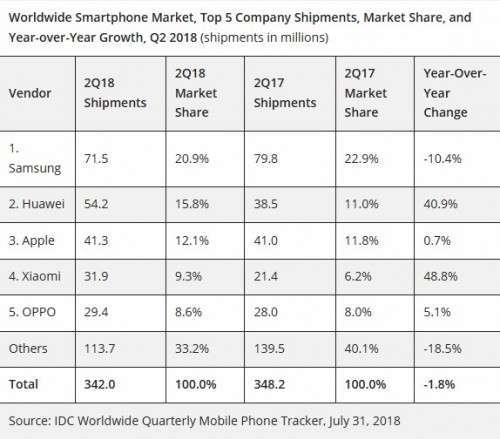Today, The International Data Corporation (IDC) releases preliminary data that shows smartphone OEMs have shipped a total of 342 million units during Q2 of this year. This calculates to a 1.8% decrease from Q2 of 2017, where OEMs shipped a higher total of 348.2 million handsets.


During the same quarter, Huawei has surpassed Apple in the number of overall shipments. The Chinese OEM shipped 54.2 million units with a record high of 15.8% of global market share and a whopping (also record breaking for Huawei) 27% market share in China. This puts Huawei at the No. 2 spot globally while Apple sits at No. 3 with 41.3 million units at 12.1% global market share.

The IDC attributes this growth in the success of Huawei in new markets as well as the wide success of Huawei’s secondary brand: Honor. Meanwhile, Huawei’s P20 and P20 Pro “found strong demand in the $600-$800 price segment”.

Samsung remains at No. 1, where it sold 71.5 million units and took 20.9% of the global market share, despite a 10.4% decrese in units shipped last year. The Galaxy S9 and S9+saw slower sales compared to the S8 and S8+, likely due to the incremental update that didn’t have S8 owners rushing to upgrade to the S9. Samsung’s Note9 is going to be announced soon and is expecting it to boost sales, in addition to releasing its Note series well-ahead of Apple’s new generation of iPhones, whose event date is yet to be announced.
Xiaomi and Oppo took the No. 4 and No. 5 spots, respectively. Xiaomi surpassed Samsung for the No.1 position in India this quarter while Oppo faced slowing down in India and Southeast Asia. Even so, Oppo grew 5.1% from last year’s Q2 as it expanded into new markets in the Middle East and Africa.





No comments:
Post a Comment